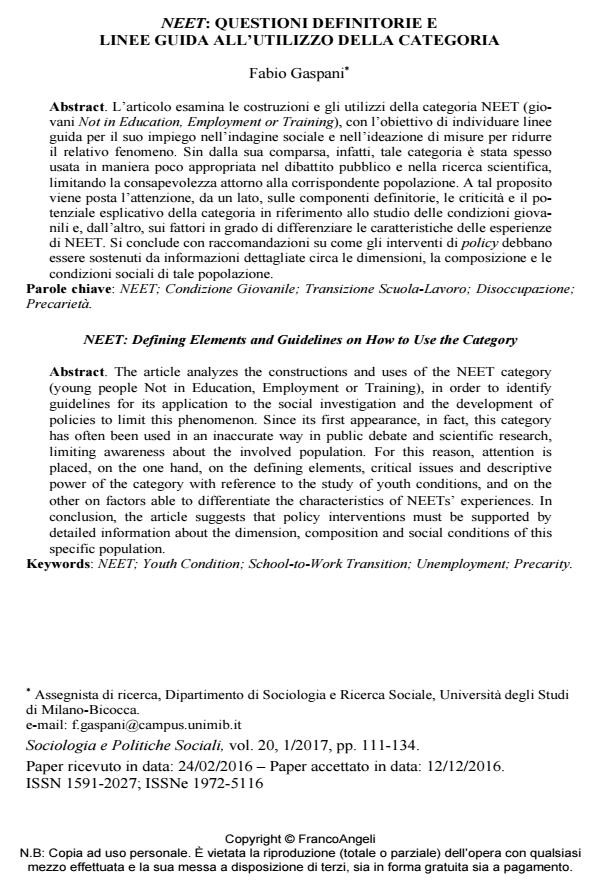Neet: questioni definitorie e linee guida all’utilizzo della categoria
Titolo Rivista SOCIOLOGIA E POLITICHE SOCIALI
Autori/Curatori Fabio Gaspani
Anno di pubblicazione 2017 Fascicolo 2017/1
Lingua Italiano Numero pagine 24 P. 111-134 Dimensione file 275 KB
DOI 10.3280/SP2017-001006
Il DOI è il codice a barre della proprietà intellettuale: per saperne di più
clicca qui
Qui sotto puoi vedere in anteprima la prima pagina di questo articolo.
Se questo articolo ti interessa, lo puoi acquistare (e scaricare in formato pdf) seguendo le facili indicazioni per acquistare il download credit. Acquista Download Credits per scaricare questo Articolo in formato PDF

FrancoAngeli è membro della Publishers International Linking Association, Inc (PILA)associazione indipendente e non profit per facilitare (attraverso i servizi tecnologici implementati da CrossRef.org) l’accesso degli studiosi ai contenuti digitali nelle pubblicazioni professionali e scientifiche
L’articolo esamina le costruzioni e gli utilizzi della categoria NEET (giovani Not in Education, Employment or Training), con l’obiettivo di individuare linee guida per il suo impiego nell’indagine sociale e nell’ideazione di misure per ridurre il relativo fenomeno. Sin dalla sua comparsa, infatti, tale categoria è stata spesso usata in maniera poco appropriata nel dibattito pubblico e nella ricerca scientifica, limitando la consapevolezza attorno alla corrispondente popolazione. A tal proposito viene posta l’attenzione, da un lato, sulle componenti definitorie, le criticità e il potenziale esplicativo della categoria in riferimento allo studio delle condizioni giovanili e, dall’altro, sui fattori in grado di differenziare le caratteristiche delle esperienze di NEET. Si conclude con raccomandazioni su come gli interventi di policy debbano essere sostenuti da informazioni dettagliate circa le dimensioni, la composizione e le condizioni sociali di tale popolazione.
Parole chiave:NEET; Condizione Giovanile; Transizione Scuola-Lavoro; Disoccupazione; Precarietà
- Persistency in the NEET state: a longitudinal analysis Dalit Contini, Marianna Filandri, Lia Pacelli, in Journal of Youth Studies /2019 pp.959
DOI: 10.1080/13676261.2018.1562161
Fabio Gaspani, Neet: questioni definitorie e linee guida all’utilizzo della categoria in "SOCIOLOGIA E POLITICHE SOCIALI" 1/2017, pp 111-134, DOI: 10.3280/SP2017-001006